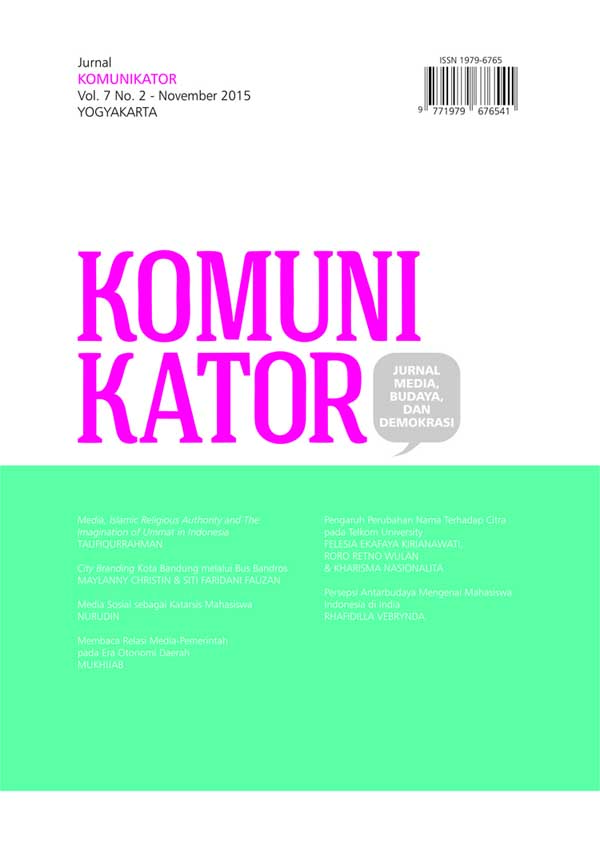MEMBACA RELASI MEDIA-PEMERINTAH PADA ERA OTONOMI DAERAH
Abstract
Ketika rezim Orde Baru dengan sistem pemerintah otoriter, bentuk dominan sebagai model relasi antara media dan masyarakat (baca = kekuasaan). Dalam rezim desentralisasi dan industrialisasi media, maka bentuk dominan digantikan oleh bentuk pluralistik. Hubungan media dan kekuasaan berorientasi pada pencapaian kepentingan politik, sosial, budaya, ekonomi dan kelompok yang bersaing. Ini berarti bahwa hubungan dua lembaga tersebut sangat dinamis. Suatu saat, media mendominasi, pada saat yang lain, kekuasaan bisa jadi lebih dominan. Kesetaraan bisa terjadi ketika keduanya menemukan kesamaan kepentingan. Situasi demikian memerlukan pisau bedah “baru” yang mampu membongkar dan mengkonstruksi bagaimana hubungan media dan kekuasaan. Artikel ini menawarkan teori homologi atau struktur homologi untuk membaca bagaimana relasi keduanya. Karena artikel ini bersifat kajian awal, penulis tidak menyimpulkan bagaimana struktur relasi media dan kekuasaan saat ini. Dengan kajian ini, penulis berharap akan mendapat respon dari pembaca untuk menyempurnakan artikel ini.
When the New Order regime (in Indonesia) with authoritarian government system, the dominant form as a model of relations between the media and society (read = power). In a decentralized regime and industrialization of media, then the dominant form was replaced by a form of pluralistic. Media relations and power oriented on achieving the interests of political, social, cultural, economic and competitive group. This means that the relationship of the two institutions is so dynamic. At one point, the media dominates, while at the other, the power could be more dominant. Equality can happen when the two find common ground of interest. Such a situation requires a scalpel "new" capable of dismantling and constructing how to media relations and power. This article offers a theory of homology or homology structure to read how relationships are both. Due to the nature of the initial review of this article, the author did not conclude how media relations and power structure at this time. With this study, the authors hope will get the response from readers to improve this article.
Downloads
Published
Issue
Section
License
Copyright
The Authors submitting a manuscript do so on the understanding that if accepted for publication, copyright of the article shall be assigned to Komunikator as publisher of the journal. Copyright encompasses rights to reproduce and deliver the article in all form and media, including reprints, photographs, microfilms, and any other similar reproductions, as well as translations.
Authors should sign Copyright Transfer Agreement when they have approved the final proofs sent by Komunikator prior the publication. Komunikator strive to ensure that no errors occur in the articles that have been published, both data errors and statements in the article.
Komunikator keep the rights to articles that have been published. Authors are allowed to use their works for any purposes deemed necessary without written permission from Komunikator with an acknowledgement of initial publication in this journal.
License
All articles published in Komunikator are licensed under a Creative Commons Attribution-ShareAlike 4.0 International (CC BY-SA) license. You are free to:
- Share — copy and redistribute the material in any medium or format
- Adapt — remix, transform, and build upon the material for any purpose, even commercially.
- Attribution — You must give appropriate credit, provide a link to the license, and indicate if changes were made. You may do so in any reasonable manner, but not in any way that suggests the licensor endorses you or your use.
- ShareAlike — If you remix, transform, or build upon the material, you must distribute your contributions under the same license as the original.
- No additional restrictions — You may not apply legal terms or technological measures that legally restrict others from doing anything the license permits.





